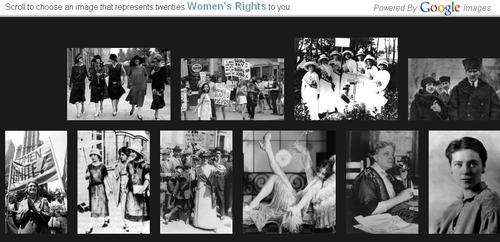Proving a Point with Google Images
When most of us think about the roaring twenties, we envision scenes of flappers cutting loose on the dance floor, bustling cities filling with new cars and buildings scraping the sky, Prohibition and citizens fighting for their rights. Right? Well, the interesting thing about Youth and Beauty, now on view, is the exhibition shows us that our visions of the decade ran counter to the twenties that artists chose to describe. As the exhibition’s curator, Terry Carbone, writes in the opening didactic:
In the new realism that typified American art of the decade, liberated modern bodies resonate with classical ideals, the teeming modern city is rendered empty and silent, and still life is pared to an essentialized clarity.
In creating an in-gallery interactive, the challenge was finding an activity that would highlight the disparity between what we’ve come to associate with decade and the idealized vision created by its artists.

What did the Jazz Age look like? Interactive asks visitors to make their own selection from an array of popular photographs to see how it compares to the imagery created by the American artists featured in Youth and Beauty.
The resulting interactive uses the Google Images API as a way to show what’s in the popular imagination of four themes related to the show. A visitor searches for imagery on a theme and is asked to select an image from Google’s results; the selected image is displayed along side a related work from the exhibition and the interactive explores how the popular imagery delivered via Google differs from the artists’ depiction.

Youth and Beauty interactive utilizes the Google Images API and runs on iPads embedded into a popular culture timeline.
Given this is a live search, the results are not always perfectly accurate to the time period, but they are pretty close. We’ve also tweaked it a bit to help the results gain a little more accuracy; turning on Google’s “safe search” and displaying only black and white imagery. The interactive runs on four iPads in the gallery where the devices are embedded into a popular culture timeline in the exhibition. You can also play with it on the web.

Shelley Bernstein is the former Vice Director of Digital Engagement & Technology at the Brooklyn Museum where she spearheaded digital projects with public participation at their center. In the most recent example—ASK Brooklyn Museum—visitors ask questions using their mobile devices and experts answer in real time. She organized three award-winning projects—Click! A Crowd-Curated Exhibition, Split Second: Indian Paintings, GO: a community-curated open studio project—which enabled the public to participate in the exhibition process.
Shelley was named one of the 40 Under 40 in Crain's New York Business and her work on the Museum's digital strategy has been featured in the New York Times.
In 2016, Shelley joined the staff at the Barnes Foundation as the Deputy Director of Digital Initiatives and Chief Experience Officer.
